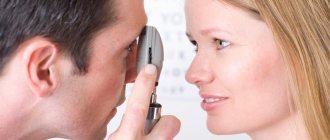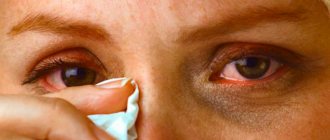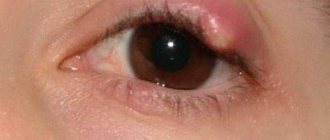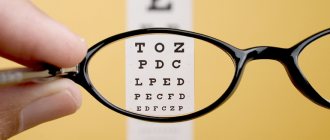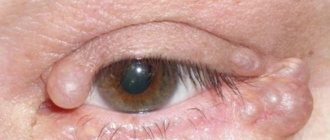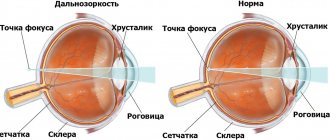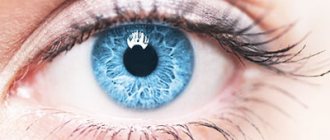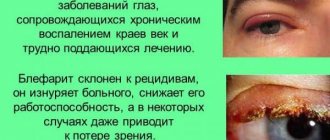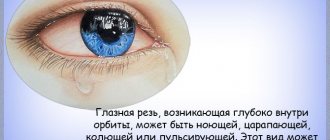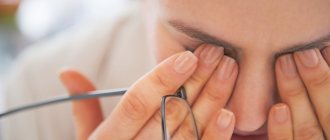A boil (boil) is an abscess that affects the skin and mucous membranes. This disease is manifested by the formation of a purulent cavity, which itches and causes discomfort. When large in size, the boil leads to limited motor activity in the muscles and a foul odor. For therapy, antibacterial ointments and drops are used (when the boil is located on the inner surface of the eyelid), as well as folk remedies. If they are ineffective, they resort to surgical intervention.
What is a boil and what does it look like?
Boils appear where hair grows. The eyelid is not the only place where a painful boil forms. A boil that has popped up between the eyebrows or a boil above the eye is also a common occurrence.
An abscess located mainly in the eyelid area is called stye. It occurs on the upper and lower eyelids with equal frequency. These boils, including boils under the eyebrow, are external boils when the hair follicle and sebaceous gland are affected.
If an abscess appears on the inside of the eyelid, bacteria enter the glands that moisturize the eyeball. The affected area is clearly visible when the doctor everts and pulls the eyelid during examination.
A cone-shaped, reddened swelling with a white-yellow dot in the middle is often confused with a pimple. However, unlike a pimple, inflammation with a boil nests deep in the skin. Through the thinned skin in the center of the abscess, only the head of the boil is visible. The necrotic core is hidden deeper.
If the boil is picked or squeezed, the infection will spread further and affect the tissue of the eyeball, which will lead to deterioration of vision.
Causes and symptoms
A boil on the eye in most cases is the result of an infectious agent, namely staphylococcus (usually aureus). That is why treatment of the disease is aimed at eliminating the infection.
The following can lead to the development of pathology:
- disturbances in the functioning of the endocrine system;
- disruptions in the functioning of the gastrointestinal tract;
- lack of basic hygiene (children’s dirty hands);
- decreased immunity;
- blepharitis (inflammation of the eyelid);
- diabetes;
- use of low-quality cosmetics;
- general hypothermia of the body.
Boils can be internal or external. In both the first and second cases, the patient will feel pain, the presence of a foreign body in the area of the boil, a feeling of warmth upon palpation, and sometimes lacrimation.
An internal boil is an abscess on the side of the eyelid that is in contact with the surface of the eye. In this case, the bacteria enter the meibomian glands, whose task is to ensure sufficient hydration of the eye. To see the inner stye, turn the eyelid outward.
An external boil will appear as a yellow spot on the eyelid with redness. It is less painful than the internal one, develops several times faster and mainly on the edge of the eyelid.
This pathology can occur in different ways, taking into account the fact that in some it constantly recurs, while in others it occurs extremely rarely. Frequent formation of styes on the eye requires a more detailed diagnosis of the general condition of the body for the presence of chronic foci of infection. Especially if boils appear on both eyes at the same time.
Why does it appear
The brow ridges and eyes are the most vulnerable part of the face. A boil on the eyelid is formed when pathogenic microflora, along with dirt, penetrates the hair follicle and the adjacent sebaceous gland. The conditions for the development and growth of pathogenic bacteria are the most suitable there. Staphylococcus multiplies quickly, and the inflammatory process begins. Pus and necrotic masses accumulate in the follicle and gland. The inflamed tissue swells and turns red.
The habit of touching and rubbing your eyes with your hands is one of the most common causes of boils. Other factors:
- Abuse of decorative cosmetics and other products, from mascara, eye shadow to creams, scrubs and lotions for washing, especially low-quality products. They dry out the delicate skin of the eyelids, which cracks, and the inflammatory agent penetrates through microtraumas.
- Cosmetic procedures, for example, plucking and shaving eyebrows, also injure the skin, and the wounds become infected.
- Allergic reactions not only to cosmetics or food, but also to pollen, dust, mold.
- Prolonged and constant contact with dust, chemicals, coupled with neglect of protective equipment, such as a mask or goggles.
- Colds and other diseases (endocrine, autoimmune) that weaken the immune system, unable to fight the causative agent of the disease.
- Taking certain medications.
- Poor diet, bad habits, for example, smoking, alcohol abuse, sweet, fatty foods, flour foods.
- Eye infections, such as conjunctivitis.
- Injuries in the eye area.
Prevention
- Low-quality cosmetics of all types and variations should be excluded from use.
Ulcers are considered safe ophthalmological pathologies, but this inflammation should not be left unattended and treated, because complications can arise here too. Boils in children are a common occurrence. In addition to the face, they can develop on the body at any age due to completely different reasons.
In this case, parents should under no circumstances wait for the purulent abscess to heal spontaneously ; they should immediately take all measures to get rid of the infection. After all, furunculosis is still a dangerous disease that can lead to complications.
If, nevertheless, it was not possible to notice something was wrong in time and prevent its development, you need to treat it in time and prevent such a development of events from happening again, actively taking preventive actions.
A boil is a purulent inflammation that can appear on any part of the skin; it is also popularly called a boil.
Furunculosis is a fairly common disease caused by staphylococci. This disease not only worsens the appearance, but also indicates internal problems of the body.
Photo 2 - Furunculosis in a child
Symptoms of furunculosis:
- the appearance of boils on any part of the body;
Photo 3 - Furuncle on the face - increase in temperature (from low to high);
Photo 4 - Possible increase in temperature - deterioration of health;
Photo 5 - The child feels weak - weakness (the child often rests during games, sleeps for a long time);
Photo 6 - The child often rests while playing - lymphadenitis (enlargement of nearby lymph nodes);
Photo 7 - Enlarged lymph nodes - headache;
Photo 8 - The child complains of a headache - decreased appetite;
Photo 9 - The child does not eat well - signs of intoxication may appear.
Photo 10 - Possible intoxication
At the initial stage, you can detect a pustule, which causes pain when pressed; gradually it begins to thicken along with the surrounding tissue. At the second stage, the hair follicle begins to fester, then the necrotic tissue is rejected and the wound heals.
Photo 11 - Painful pustule appears first
Attention! If the wound is deep enough, visible scarring may remain on the skin for life. To prevent this, you should pay attention to any complaints of the child and regularly examine the body for any abnormalities.
As mentioned earlier, boils can affect any part of the body and they can cause a lot of discomfort to their owner. Well, how can a child calmly sit at his desk and learn his homework if he has a boil on his butt?
Photo 12 - Boil on the butt
Even more trouble is guaranteed if it is on the face: in the nose, on the lip, on the eye or under the eye. The appearance of a boil in the throat can cause difficulty breathing or swallowing food. The most painful boil is considered to be in the ear, and the most difficult to detect is on the head.
Boils can occur both on rough skin (on the leg, on the knee, on the back) and on soft skin (under the armpit or on the foreskin). In any case, treatment should be started immediately when the first signs of the disease appear.
Photo 13 - Furuncle on the face
Photo 14 - Boil in the nose
Photo 15 - Boil on the lip
Photo 16 - Furuncle in the ear
Important! The risk group includes areas such as the nasolabial triangle, neck, genitals and natural folds (groin, armpits, intergluteal area).
Even a small child who has just been born can develop an unwanted abscess. A child under one year old is admitted to hospital and treated in a hospital. Parents can take children who are already 2 or 3 years old home and carry out the treatment themselves.
Stages of boil development
A boil under the eye develops gradually:
- At the initial stage, the area around the hair follicle turns red. Fluid with blood fragments accumulates in the tissues. Minor swelling appears. This stage is called infiltration.
- The affected area swells more. The person feels itching and tingling. If a boil forms in the eyelid area, profuse lacrimation begins. Thick discharge is noticeable on the eyelashes and in the corners of the eyes. The stage of suppuration begins.
- The inflamed area rises, and a white dot is clearly visible in the center of the painful cone-shaped formation under the thinned skin.
- The boil matures and bursts. The pus comes out, and the necrotic core is rejected. After the abscess breaks through, a fairly deep wound remains, which heals if the process proceeded without complications.
The stages progress differently depending on your overall health. A person often feels general malaise, chills, and pain in the affected area. After the boil has broken through, the swelling subsides and body temperature returns to normal. Next comes the healing stage.
Causes
An infectious process that affects healthy tissue can provoke the appearance of a boil (furuncle) under the eye. As a rule, the causative agent is a staphylococcal infection. But the infection itself is not enough for the development of pathology. This requires an additional effect on the patient’s body, which provokes the development of the inflammatory process.
A boil can occur for various reasons
Among all the factors contributing to the appearance of boils on the eye, it is worth highlighting the following:
- blood poisoning as a result of cuts or microtraumas;
- exposure to low temperature;
- severe stress;
- hormonal imbalance;
- disruption of metabolic processes in the body;
- weakening of the immune system;
- development of acute infectious diseases;
- chronic diseases;
- the appearance of excess weight due to an unbalanced or unhealthy diet;
- failure to comply with personal hygiene rules.
Infection with a staphylococcal infection in combination with one or more of the factors listed above often leads to the formation of a boil on the eyelid or eyebrow.
What is the danger
If the boil on the eye becomes complicated, the infection spreads to healthy tissues and organs of hearing and smell. A person develops diseases such as otitis media and sinusitis. Pathogenic flora affects the lymph nodes. In the most severe cases, sepsis and inflammation of the membranes of the brain begin.
An untreated boil of the eye threatens a person with deterioration or even loss of vision. Self-medication and attempts to open or squeeze out a boil on your own lead to disastrous results.
The formation of several boils on one eye is also dangerous. This significantly increases the risk of infection spreading to other organs and parts of the face, for example, to the eyeball, because the affected area occupies a large area.
Treatment
To receive treatment, you must consult with your doctor. Opening a boil on your own is unacceptable; it will lead to the formation of an additional infection that will spread to deeper tissues. The risk of severe tissue damage increases. Complex therapy is used aimed at eliminating the formation and preventing the possibility of its recurrence.
Medications
Since the boil is caused by the proliferation of a bacterial infection, the following drugs are used:
- antibacterial drops (Levofloxacin, Ciprofloxacin, Vigamox, Tobrex), the treatment method is safe for children of all ages, as it is used for local therapy;
- antibacterial ointments (Erythromycin, Tetracycline ointment, Levomekol);
- antiseptic solutions (Furacilin, Albucid).
Drugs that help accelerate the maturation of formation are also indicated:
- heparin ointment (attracts pus to the skin);
- Vishnevsky ointment (has an anti-inflammatory, antibacterial effect, helps improve the immune response) promotes rapid breakthrough of boils and further tissue healing.
Surgical procedures
This method is indicated when the boil remains in front of the patient for an excessively long time. It can only be performed by an ophthalmologist or surgeon. It is prohibited to remove the boil yourself, as this will lead to the spread of infection and tissue damage.
The doctor uses a scalpel, with which he makes an incision at the top of the boil, removes its contents, and applies an antibacterial drug. To accelerate tissue healing after surgical removal of a boil, the doctor may prescribe drugs that promote accelerated regeneration, for example, Solcoseryl. To reduce inflammatory reactions, use anti-inflammatory drops. It is necessary to strictly adhere to the surgeon’s instructions after removing the pus.
How to distinguish a boil from other inflammatory processes
A boil on the eyelid does not look like a regular pimple. Inflammation affects a large area. The inflamed area swells, the tissue around it swells greatly.
This pathology is often accompanied by severe pain, not only in the affected area. The head hurts, the person experiences thirst, nausea. The temperature rises, nearby lymph nodes enlarge, which are also very painful to the touch.
The formation, which is called stye, depending on the stage of development, can be compacted, reddened, and protrude above the surface of the skin. In the center of a painful, dense and hot area, surrounded by a bright red area, the head of the boil is clearly visible.
A sharp deterioration in general condition does not accompany the appearance of ordinary acne.
Complications
Since it is a purulent inflammation, it can cause sepsis , that is, blood poisoning. In addition, inflammation of the lining of the brain can develop, then inflammation of the brain itself. Patients often experience:
- increased (or decreased) body temperature;
- general weakness;
- the person may experience severe headaches;
- urge to vomit;
- sometimes paralysis.
With this type of boil, independent opening is extremely undesirable. There is a great risk of introducing even more infection.
Medication
When visiting a doctor in the first stages, they most often resort to treatment with antibacterial drops if we are talking about an abscess on the eyelid. But this does not always help. In case of complications or inflammation, they resort to using various ointments . Vishnevsky ointment, erythromycin ointments. The substance must be applied directly to the abscess several times during the day until opening.
How and with what to treat? The doctor can prescribe a whole range of antibiotics in a certain sequence. When ripe, an autopsy is practiced, followed by removal of pus. Afterwards, a sterile bandage is applied. The surrounding skin is lubricated with ointment.
When there is a boil on the eyelid, the development of the abscess is stopped with antibiotics . Injections of penicillin, cefotaxime, etc. are prescribed. The boil is lubricated with ointments, and eye drops are instilled before bedtime. Broad-spectrum antibiotics are prescribed. In this case, the process can be started to such an extent that hospital treatment is required.
They use dry heating procedures, UV irradiation, and UHF. It is suggested to lubricate the skin with camphor oil, and alcohol compresses can also be prescribed.
Surgical
Used as a last resort, if no other methods have helped or the process is too advanced. In this case, it is treated surgically.
The patient is under general anesthesia, the doctor makes an incision and then extracts the pus. Then the area is washed and drainage is applied.
The doctor can use a special needle or, nevertheless, make an incision to allow the pus to come out. It is strongly not recommended to do this on your own.
There are recurrent appearances of an abscess on the eyelids - recurrent furunculosis . In such cases, immunotherapy is prescribed. A course of taking a staphylococcal vaccine is practiced.
Traditional methods
Mix a spoonful of soap and the same amount of honey in a water bath, adding a tablespoon of flour to the mixture during the mixing process. Make a cake from the resulting mixture and apply it overnight, securing it with a bandage.- You can boil an egg, wrap it in a clean cloth and apply it to the infected area until it cools down.
- Pour boiling water over the crushed plantain leaves and let it brew. Then dip a piece of gauze into the liquid, and then apply it to the abscess for up to half an hour several times a day.
- People practice the use of calendula. In dried and crushed form, pour boiling water over two spoons of it, let it brew, then proceed as in the method above.
- A compress based on chamomile is applied for a quarter of an hour to relieve pain and speed up the release of pus. Then cover the boil with a bandage with ointment (for example, Vishnevsky). If the abscess has opened, carefully remove the pus and rinse with hydrogen peroxide.
- Rinse with black tea.
- Applying fresh cucumber slices.
How to cure a boil in the eye
Treatment for chiryak on the eye begins at the first signs of the disease. It is better to see a doctor who will prescribe a general blood test. Staphylococci can be resistant to antibiotics, therefore, if a boil is treated with medications, an analysis of the contents of the boil is performed. The result reveals the pathogen and the sensitivity of pathogenic microflora to medications.
In some cases, surgical intervention is required:
- drug therapy or exposure to the affected skin near the eye with local preparations (ointments) does not produce results;
- the boil occupies a large area and threatens a serious complication (for example, blurred vision);
- the patient's condition deteriorates sharply.
Treatment is prescribed by a dermatologist. Visits to traditional healers and the use of alternative remedies are dangerous. Self-medication will not give results and will lead to complications, especially if the boils arise constantly and affect a wide area. Then an integrated approach is required, which consists not only of treating abscesses, but also of fully examining the patient.
Medicines from the pharmacy
Drug therapy is one of the methods to treat a chiryak on the eye. Eye drops, gels, ointments for the treatment of chirium on the eye are purchased according to a doctor’s prescription.
Drug therapy for boils is carried out at home, strictly following the dosage prescribed by the doctor. Use:
- Dicloxacillin, Erythromycin, Tetracycline are long-acting antibiotics that are included in eye ointments that effectively fight staphylococcal infections.
- Eye drops Albucid, Tobramycin, Ciprofloxacin are prescribed if a boil develops next to the conjunctival sac.
- Sterile bandages soaked in a solution of silver nitrate are applied to the eye area.
- The sore spot is injected with novocaine. The procedure relieves a person from painful sensations.
How to treat a boil on the eye at home
Treatment at home is carried out under medical supervision. Before squeezing out a boil on the eyelid or a boil on the eyebrows, applying compresses, or using folk remedies, the patient should consult a dermatologist.
Some lotions, compresses, bandages on the eyes and in the area of the boil on the eyebrows or under the eye are acceptable. Home remedies include herbal ingredients recognized by official medicine.
For example, lotions made from aloe, lilac or calendula relieve pain, relieve swelling and slow down inflammation. A calendula compress using dried inflorescences will produce a good effect:
- Brew 2 tablespoons of calendula flowers purchased at the pharmacy with a glass of boiling water.
- Insist for half an hour, preferably an hour.
- Moisten a sterile cotton pad, gauze or napkin with the infusion.
- Apply to the boil.
In addition to calendula, other medicinal plants are used:
- One aloe leaf is crushed.
- Pour in 250 ml of warm water.
- Infuse for 60 minutes.
A cotton wool or cloth is moistened in the resulting infusion and applied to the boil.
They also use fresh lilac flowers, chamomile, and strong black tea, which has a tannic and aseptic effect.
To prepare a restorative anti-inflammatory tea, you can use bay leaf. It is soaked in boiling water (5 bay leaves per 100 ml of water), infused and drunk in small portions throughout the day. Rose hip decoction strengthens the immune system and fights inflammation.
Use folk remedies together with medications prescribed by a doctor. It is better to buy plant materials at a pharmacy. Aloe is often grown at home. In this case, the freshly picked leaves are thoroughly washed with soap and running water before use.
Surgical methods
If the boil of the eyelid occupies a large area, it is removed. Surgical intervention quickly relieves the patient of pain and improves general condition.
To remove a boil on the eye, the surgeon cuts or pierces the skin over the stye. The wound, cleared of pus and necrotic masses, is disinfected and a sterile bandage is applied. It is recommended to treat the area with aseptic ointments, which prevent inflammation and speed up healing.
Chiria of particularly large size are removed along with the surrounding tissue and eyelash follicle.
Treatment methods for boils are prescribed only by a doctor after examining the patient.
Principles of treatment and diagnosis
There are a few simple tips to follow if you have a boil under your eye. It is necessary to stop using any cosmetics and not use contact lenses until the treatment course is completed.
The well-known method - treatment with an egg or heating the barley should not be used, since accelerating the purulent process of the boil can have its consequences.
Swelling under the eye can be relieved with tea, but if the main cause of the disease is infection, then you cannot do without the help of special medications. Swelling under the eye can also be treated with calendula decoction, but only in combination with therapy prescribed by a specialist.
You can also treat a boil with compresses made from fresh aloe leaves, the juice of which relieves inflammation and is a good antiseptic. Treatment of boils is, first of all, based on eliminating the main cause and only then the consequences and accompanying symptoms of the disease. Therefore, it is better to treat a boil under the eye based on the doctor’s recommendations.
Any chosen folk method for relieving swelling, redness and purulent accumulations should be agreed upon with the treating specialist so as not to harm yourself. Basically, when treating boils on the eye, doctors follow a standard scheme in two directions - surgical or conservative.
First of all, therapeutic therapy begins with treating the boil with antiseptic agents. This can be Levomecithin, Erythromecin or Tetracycline ointment, which are based on an antibiotic that can fight staphylococcal infections. Specialists will treat stye using drops with an antiseptic and antibacterial effect.
At the same time, such drugs will be selected depending on other drugs. If an ointment, for example, is prescribed from the tetracycline group, then the drops will be from a different category of drugs. This approach is necessary so as not to exceed the permissible dosage of the main active ingredient.
Basically, doctors prescribe drugs like Albucid, Ciprofloxacid or Tobramycin as the most effective eye drops. Among the medicinal methods of treatment, it is also worth highlighting various types of compresses. They are made using clean gauze soaked in special medications, which are applied to the sore spot for several minutes or hours.
Experts recommend a sterile bandage soaked in a one percent silver nitrate solution. This type of dressing should be used twice a day. Another way is to inject novocaine into the affected area. This approach will immediately relieve pain, and the use of antibiotic-based ointments and drops will speed up the process of boil maturation.
If extensive damage to the eye occurs and several more boils appear in place of one, then the specialist may decide to use a surgical treatment method.
Injection with any drugs should only be carried out by a qualified doctor. The doctor, using local anesthesia, opens all the boils that appear and treats the areas that have undergone surgery with antiseptics. Subsequent treatment continues with the use of antibiotics using injections and special ointments.
Source: otekam.net
Traditional treatment for boils on the eye
One of the methods for treating a boil on the eye is surgery.
As a rule, this is carried out in a clinic by experienced doctors. Most often, surgical treatment of a boil on the eye is required in cases where all other methods do not help. The procedure involves giving the patient local or general anesthesia, as a result of which he does not feel pain. Then the doctor surgically removes the pus from the boil, having previously opened it. After this, the cavity is washed, disinfected, and medicine is injected there. This will promote rapid healing of the wound, and the pus will not spread throughout the body. If you have started treatment for a boil on the eye and complications have already begun, you may need additional treatment in addition to local treatment. It consists of strengthening the overall immunity of the body. Usually this is extremely necessary for people who suffer from other concomitant serious diseases that exhaust the body's defenses.
To prevent the reappearance of a boil in the same place, it is recommended to treat the affected area with Vishnevsky ointment or ichthyol ointment for some time. This way you can avoid furunculosis - a disease when boils spread to different parts of the body due to the release of pus residues into the blood.
Another popular treatment method is medication. Here, too, consultation with a doctor is important, since the point of treatment is to use strong antibiotics. It is dangerous to choose a medicine on your own, especially if you need to treat a boil for a child or if you are a pregnant woman.
Usually, it is drug treatment that gives the best possible effect: the disease goes away within 3-4 days, and all painful sensations are reduced to a minimum.
Today there are quite a lot of drugs for the treatment of boils, so let’s look at them in more detail. The most effective remedy is dicloxacillin. This remedy is the most powerful in the fight against staphylococcal infection, which causes boils. In addition, tetracycline and erythromycin are widely used.
They are produced in the form of ointments and belong to the group of antibiotics with prolonged action. But in any case, the doctor will first do an analysis that will reveal the type of staphylococcus that caused the boil. If the boil appears on the conjunctival sac or very close to it, then it may be more advisable to use special eye drops, which the doctor will prescribe.
These can be drops such as albucid and tobramycin. There are several other medicinal methods for treating boils on the eye. The first is to apply sterile dressings that are soaked in a solution of silver nitrate (1%). Such dressings should be changed 2 times a day. This treatment method will provide complete rest to the affected area of the eye.
Another way is to inject the boil with novocaine on all sides. This method allows you to get rid of unpleasant sensations quite quickly. Antibiotics from the inside will promote the maturation of the boil and the rapid exit of the rod. But only a doctor should do the injection, and until you recover, you should be under his supervision.
Drug treatment begins with a visit to an ophthalmologist. Treatment will be faster and more painless if you visit a doctor when the first symptoms appear. As a rule, the medicine is prescribed in the form of drops or ointments with an antibacterial effect. Treatment with drops. At the first symptoms, drops are traditionally prescribed - 30% albucid.
Depending on the complications, drops may also be prescribed: ciprolet, ciprofloxacin, chloramphenicol, tobrodex. Before using the drug, warm it up by holding it in your palms for 3-5 minutes. If there are no close people nearby who will help with the instillation procedure, you will have to do it yourself. First you need to wash your hands well.
Wrap the finger that will be used to tighten the eyelid with a bandage or gauze. Sit in a position where you can comfortably tilt your head back. Rolling your eyes up, try to ensure that the falling drop gets into the inner corner of the eye (such instillation will allow the medicine to distribute throughout the problem area on its own).
After using some drops, such as chloramphenicol, a strong burning sensation may occur. Treatment with ointments is no less successful than with drops.
Ointments such as tetracycline, erythromycin and hydrocortisone contain gentomycin and chloramphenicol, which are antibiotics. The ointment is applied to the problem area and has an advantage over drops in that it acts directly on the boil, instead of spreading over the entire eye.
Surgery is performed for extensive infection, which manifests itself in several boils at the same time. The doctor, under the influence of local anesthesia, opens the abscesses and, after cleaning the wounds, applies medicine. Often subsequent treatment may include antibiotic injections.
Source: netpryshhei.ru; vseokozhe.com
Folk remedies for boils
Turmeric will help clear the skin of ulcers.
The substances that make up this spice help eliminate the inflammatory process and maintain the normal functioning of the digestive system. In addition, turmeric is similar in its medicinal properties to antibiotics. Pastes for external use and juices for internal use are prepared from this plant. With the help of these remedies you can relieve inflammation in the shortest possible time. The use of pulling ointments is an ideal option to speed up the process of formation of a pustule - the head of a boil. After it is formed, the lesion will open on its own and the purulent contents will leak out. To prepare a healing ointment you will need: turmeric (powder), ginger, honey and salt. Grind the ginger, add half a spoon of ginger, a spoon of honey and a little salt, literally a pinch. Mix the ingredients thoroughly, then place on a piece of gauze and apply to the affected area. If you want, you can put cling film and another layer of cheesecloth on top of the gauze.
This way the abscess will always be warm and, therefore, will go away sooner. Beeswax ointment. Melt the butter, cut out the wax and add it to the melted butter. Heat until the wax is completely melted, but do not bring to a boil. Apply this ointment as a compress, but without using cellophane.
Laundry soap in the fight against purulent abscesses. Take a bar of laundry soap and grate it. At the exit, the crushed soap should cover the bottom of the iron mug in one layer, then fill it with milk. Place on the stove and heat over low heat for an hour. Don't forget to stir periodically.
Apply the prepared ointment to the inflamed area, then bandage it and keep it on for at least five hours. Repeat the procedure until the boil disappears.
Making onion ointment. Take one onion, cut it into four parts and place it in the oven. After half an hour, remove the onion and pound until mushy. Grate the laundry soap and add to the onion pulp, mix well. Apply this product to the affected area and secure with a bandage.
Do not remove the bandage during the day. Onions baked in the oven are used in other ways. You need to apply it to the boil and then secure it with a bandage. This dressing needs to be changed every four hours. Cure with potatoes. You need to take one potato, peel it, wash it thoroughly and cut it into slices.
One such plate should be applied to the sore spot and then bandaged. This dressing is changed three times a day. Treatment of abscesses with agave. Take a medium aloe leaf, wash it thoroughly, cut off the spines and lightly chop with a knife (until the juice begins to stand out). After this, apply it to the abscess and bandage it. Change the dressing every five hours.
There is another effective remedy for treating boils using aloe. To prepare it you will need olive oil and agave juice. The ingredients must be mixed thoroughly. Then take a piece of bandage or gauze, soak it in the resulting liquid and apply it to the area affected by the abscess.
Place cellophane and gauze on top, then secure the compress. You need to walk with this compress for 24 hours, then replace it with a new one. The duration of the course is until the boil disappears. Fir oil will help eliminate the abscess. Take the oil and mix it with Vishnevsky ointment, then mix thoroughly.
Apply this mixture onto gauze and apply it to the sore area, then wrap it in compression paper and bandage it. Change the compress three times a day. You can, of course, use pure fir oil, but since a burn may occur, it is better to dilute it with ointment and use it in this form.
Source: narodnymisredstvami.ru
Features of treating a boil on a child’s eye
A boil under a child’s eye often appears if the baby actively rubs his eyes with his hands. Children crawl, pick up toys from the floor, pick flowers, fall, cry, and at the same time actively rub the skin of their eyelids with dirty fists, smearing dirt and tears. It is not surprising that the skin becomes inflamed and boils appear on the eyelids.
Most often, the doctor prescribes eye drops or ointments, prescribes painkillers, and a vitamin complex to maintain the body.
A chiryak on a child’s eye is accompanied by:
- pain, headache, throat, ears may hurt;
- fever and chills;
- nausea, loss of appetite;
- deterioration of general condition.
With such symptoms, adults seek help from a doctor without delay. Treatment begins as early as possible. After examining the patient, the dermatologist decides how to treat the boil on the child’s eye. Trying to eliminate a boil using home methods is prohibited!
Types of boils
Due to the various causes of occurrence, the individual characteristics of each child’s body, as well as the stage of formation, boils can appear in different forms.
Dermatologists distinguish the following classification of types of boils::
- Single abscess. It is this type of formation that occurs most often; getting rid of a boil will not be difficult.
- A small group of abscesses merging into one (carbuncle).
- Inflammation followed by decay of the deep layers of the skin - cystic acne furunculosis. Quite often it forms on the face of teenagers.
There are other species that are never localized in front of children.
What to do is strictly prohibited
A boil on the eyelid should never be squeezed out or removed by yourself. The proximity of the infectious focus to the brain, organs of hearing and smell poses a serious risk to the patient’s health. The contents of chiria can get on the membranes of the eyeball, penetrate into the ear canal, and nasal sinuses, which will contribute to the spread of the inflammatory process. If pathogenic microflora enters the bloodstream or lymphatic ducts, sepsis or lymphadenitis may occur.
A boil on the eye is removed in a hospital. The operation is performed by a surgeon.
Furuncle in a newborn
The worst thing for young parents is when a boil appears in an infant. The baby still has a very weak immune system, not accustomed to all environmental irritants, so young children need to be looked after especially carefully: bathe them, change diapers on time, continue breastfeeding if possible, and examine the child’s body.
Photo 31 - Furuncle in a newborn
It is easy to notice a boil on the butt, stomach or back, but you also need to look in the ear, on the head and other parts of the body. The causes of furunculosis in infants are the same as in older children, but treatment requires greater responsibility, so it is carried out exclusively in a hospital under the constant supervision of doctors. If neglected, there is a risk of developing dangerous complications, including meningitis.
Photo 32 - Examine the child daily
Attention! Treatment with traditional methods in childhood is extremely undesirable; this can only further aggravate the problem. It is also not recommended to try to independently remove the rod from a one-year-old child. If the abscess has not yet matured, the rod will rupture and treatment will take a long time.
Photo 33 - Newborns are treated only in a hospital
For minor skin lesions, the doctor may allow you to treat a 3-month-old baby at home. Since this is too young an age to take antibiotics orally, they are used externally.
Photo 34 - For children under one year old, antibiotics are applied externally
To do this, wash the boil and apply an antibiotic prescribed by the doctor. For faster maturation of the abscess, it is recommended to apply warm compresses.
Photo 35 - Apply warm compresses
After treatment, parents must wash their hands with soap and water, as well as wash the baby’s bedding and clothes.
Photo 36 - After treatment you need to get rid of all germs
A disease that accompanies the inflammatory process in the hair follicle and surrounding tissues is called a boil (boil, barley). A boil on the eye appears for a number of specific reasons, with early symptoms and obvious signs of a specific disease. Timely seeking medical help will help avoid unwanted complications of the disease.
Preventive measures
It is best to prevent the formation of boils. Simple precautions must be followed:
- Wash your hands thoroughly and do not rub or touch your eyes.
- Lead a healthy lifestyle.
- Wash your face and eyes with running water without using soap.
- Wear safety glasses or a mask if conditions require.
- Do not use other people's hygiene products or cosmetics.
- Monitor your eye health and condition.
- Be in the fresh air.
- Work in optimal lighting.
- Make sure your eyes don't dry out.
The rules for preventing pustular diseases are simple, but they allow you to avoid conditions that threaten your health. Adults should monitor children and teach them to take care of their eye health.
Methods for preventing boils on the eye
It is important to treat any disease in a timely manner and not to neglect it, in order to prevent a decrease in the body’s protective immune forces.
If you want to reduce the risk of developing a boil on your eye and prevent the subsequent need for treatment, follow a few simple tips:
- Use only high-quality and hypoallergenic cosmetics.
- Practice regular eye hygiene.
- Avoid getting dust, foreign bodies, etc. into your eyes.
Betsik Yulia, medical columnist
6, total, today
A furuncle (boil), popularly simply “abscess,” is a purulent-inflammatory process, most often caused by staphylococci.
The sites of development may be the hair follicle sacs and sebaceous glands. The outbreak can be both singular and plural.
In this article we will learn about the symptoms of this disease, as well as learn about methods of treatment and prevention. We will also be able to find out what types of boils there are and what complications there may be.
What should you not do if you have a boil?
To speed up the healing process during treatment, it is recommended to follow a number of restrictions. It is necessary to completely avoid contact between eyes and hands, and, if possible, do not use contact lenses or cosmetics.
To prevent the accumulation of pathogenic microorganisms around the eye, there is no need to cover the formation with a band-aid. Since the disease is infectious, it is necessary to use individual dishes and towels so as not to infect someone else.
After the purulent contents are released, you should carefully remove it with a cotton swab and treat the wound with an antiseptic. There is no need to apply a bandage or bactericidal patch.
It is strictly forbidden to squeeze out the boil or warm it up, as there is a risk of blood poisoning or the development of acute thrombophlebitis (inflammation of the vein and blood clot formation)
